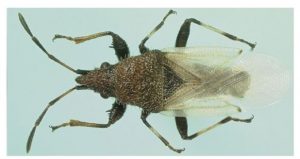The California Department of Food and Agriculture has issued an advisory that it has found cotton seed bug (CSB) at three different nurseries in San Diego County this month. Six (6) adult CSB were found at a nursery in San Marcos, one (1) adult CSB was detected at a nursery in Vista and eight (8) more were found at a nursery in San Diego. With all of the detections, all flowers and fruiting bodies (seed pods and/or seeds) will be removed from the plants on hold. Foliar treatment commences within the week along with reinspection in 30 days. San Diego County is continuing survey efforts at the nursery and surrounding areas, as well as conducting trace back and trace forward activities to determine potential origin of the CSB and any potential shipments of host material. CSB is a small (adults are ~4mm long), brownish-black, nondescript true bug. The primary food of adults and nymphs is seed of plants in the family Malvaceae, including Hibiscus, Malva, Abutilon, and (based on California detections) Lagunaria. Agricultural hosts include cotton, okra, and kenaf. Lagunaria patersonia trees appear to be a potential preferred host, as the seeds are present on the tree for long time periods. Damage to cotton seed is reported to impact oil quality and reduce seed germination up to 75 percent. CSBs cause staining of cotton lint when their bodies are crushed during harvesting and processing. The Department has conducted a visual survey to look for CSB in nurseries since 2023. In 2024, the Department surveyed a total of 49 nurseries for CSB in Los Angeles, Santa Barbara, San Diego, Riverside, Orange and Ventura counties. The nurseries were chosen based on the likelihood that they would have Malvaceous plants present ideally with seed pods. No CSB were found during this or past Pest Detection and Emergency Projects nursery and ornamental surveys. Th Department continues in 2025 in conducting a CSB survey in nurseries located in Orange, Los Angeles, Ventura, Santa Barbara, Riverside, Santa Clara and San Diego counties. At least 54 sites will be surveyed during the 2025 survey. Production nurseries that ship Malvaceous plants out of state will be prioritized. In addition to these nursery/ornamental surveys, the Department is continuing to partner with the United States Department of Agriculture to conduct survey in commercial cotton and okra and monitor the spread of this pest. No CSB has been found in production cotton or okra in California to date.
